“What is Rock Climbing?” was the biggest question for me when our neighbors introduced us to rock climbing for my son. For me, rock climbing would be an outdoor sport where you would climb a real rock and up a mountain. Even though Florida provides an outdoor sporting environment with beautiful beaches, plentiful lakes, and warm weather all year round. It is not known for its massive mountains. Florida was not our first choice for climbing mountains.
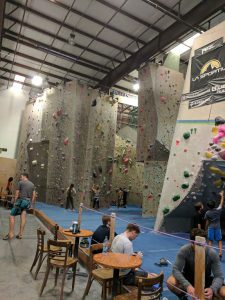
“Yes, Orlando does not have an outdoor climbing place but we have an indoor one.” My neighbor replied to my skeptical looks. We were curious so we followed our neighbors to Aiguille Climbing Center. We were introduced to an indoor rock climbing gym. I didn’t even realize there was rock climbing for kids existed let alone rock climbing competitions. It was a brand new world for my son. I was mesmerized by the colorful artificial rocks on walls and intimidated by the vertical height of the rock climbing wall. After my son’s first try out with the rock climbing team, Zephyr loved it and we signed up.
I always have known that there is rope involved in the rock climbing process but I didn’t know all the different options and the details of climbing an artificial wall. As my son progress in training for a rock climbing team, I learned a lot more about the process. In this article, I will share with you the different options in rock climbing which may help you to decide which option would work best for you in an indoor rock climbing environment.
There are three different venues in an indoor climbing gym. We have bouldering, sport climbing, and lead climbing.
Bouldering
Bouldering is climbing without rope or harness. The climbing gears you want to have are rock climbing shoes, chalk, and a crash pad. Normally for an indoor climbing center, the floor around the bouldering area is padded so you do not need to bring a crash pad. The climb is generally no taller than 6 meters (20 feet) high. The objective is to figure out how to climb up to the top of each route. The routes are usually color-coded or marked so the challenge is to climb those designated routes. Although the bouldering route is short, it could be very challenging which may require balance, strength, technique, and mental strategy. Each route is graded according to the route setter from very easy (v0 grade) to very difficult (v17). If you are curious and interested to learn more about bouldering grades, click here to learn more.
You do not need a lot of experience to start with bouldering. It is not as intimidating in height as climbing with the rope. If you do fall, there is a soft matte underneath when you land. Generally, it would be helpful if there is a spotter underneath to support your fall if you go higher than 8 feet.

Every climb is a bouldering problem varying the degree of difficulty. I found bouldering is more stressful for my body as an older climber. Because the route is short and quick, the challenge is much more intense and requires more strength, agility, and flexibility. It does require more upper body strength and a fearless mentality as you climb the more difficult routes including routes with the overhang. The holds seem to be rougher on my hands than sport climbing. The biggest fear I have with rock climbing is falling. I do not like to fall. Even if it did not seem very high from another spectator’s point of view, when I am climbing on a bouldering route to the top, it appeared that I am way up high. Younger climbers would jump down to the soft pad from the top of some routes and thought nothing of it. For me, it took lots of practice in building confidence on climbing up and down before I have the nerve to jump. Once I did it then it seemed almost silly but the initial jump was terrifying. That is my mental block, the fear of falling.
The climbing shoes and chalk are very helpful. The shoes support your feet while the chalk supports your hands. Both help you stick to the wall longer. Your feet and legs are a great big help to ascend the vertical wall. It’s a mental practice of trust on the shoes in transferring all my weight to one foot on a small itty bitty hold and lunging to the next hold. My hands do not get too sweaty when I climb so I use chalk infrequently. I mostly use chalk when I climb holds that are slopers. They are slippery and have very little ridges on the hold to grab. The chalk gives me a little friction and hopefully prevent me from slipping right off. Slopers are holds that are round or oval in shapes varying in sizes with minimal ridges or bumps on the surface. They are mostly smooth.
There are a handful of advantages to bouldering. It is a social sport. Because the routes are short and sweet, you have more time sitting on the sideline while resting and meet other climbers who could relate to your struggles and/or accomplishments. You may end up chatting with other climbers discussing strategies or also known as a beta for the route. I found most climbers are very friendly and supportive. Another advantage is that your upper body especially back and shoulders along with your abdomen strengthen tremendously when practicing routes with overhangs. Your footwork also improves because of the flow of the routes guides you to move or maneuver a certain way in order to get to the top. Bouldering is also simple and easy to learn. Also, last of all, you do not have to invest much in equipment or need a partner in order to climb.
Sport Climbing – Top Rope

Sport climbing is climbing with a rope. For an indoor gym, there are two types of sport climbing: Top rope and Lead. The top rope is where the rope is looped to an anchor on top of the route.
It’s an internal joke in my family with the distinction between sport climbing and bouldering. When I first learned to climb, I made a claim that sport climbing and bouldering are totally different. My husband argued and said they are the same. My son wanted to support me in the argument. With a serious youthful face, he said the cutest and funniest thing “Yes, rope climbing and bouldering are totally different except for the climbing part.” They are different yet the same. You can be the judge as you learn more about rock climbing.
For top rope in a rock climbing gym, we need a rock climbing harness, a pair of rock climbing shoes, a belay device, a locking carabiner, chalk, and a friend. Mentally, I am less intimidated when climbing top rope. I know when I fall I will be caught by a belayer hopefully paying attention to my climb. The route is longer and higher up. It can be as high as 30 to 40 feet varying with the different sizes of the climbing gym. When I climb, I usually do not look down. I am focused on the climb up, finding and feeling out the next best move to get to the top.
A friend is commonly necessary for top rope but some indoor gyms have auto-belay mechanisms that allow you to climb without a partner. In case of no auto belay system, the climbing gyms require you and your friends to be certified belayer first before you can climb in their gym. As a new belayer and a climber, you will be taught how to tie a figure-eight knot with a rope, how to work the belay device, how to lower your climber down the wall, and how to communicate with each other with rock climbing terms effectively while climbing.
Similar to bouldering, sport climbing also varies in difficulty by different grades. The easiest is a grade 5.0 and the hardest is a grade 5.15. If you are curious to learn more about sport climbing grading, here is an article that gives more details on the sport grading system: https://www.rei.com/learn/expert-advice/climbing-bouldering-rating.html.
The number one advantage of top rope is that I am on a rope. This helps reduces the fear of falling from my brain. Because the sport climbing route is longer than a bouldering route, the climb is less intense and less stressful on the body until you reach a more difficult grade such as a 5.10 and up. This allows you to work on the footwork, build endurance and stamina. Another advantage of rope climbing is that I can climb with my son and my husband. My daughter is not interested, at least at this time. I am enjoying the climbs and spending time with my husband. It’s a sport that I can physically keep up with him. Finally, another advantage for me with top-rope climbing is that I get a nice work out while having fun. Climbing in a gym three times a week for the past four years has toned my body amazingly. It is so great to feel good, have a fun time, and look physically fit doing a sport that I love.
Sport Climbing – Lead
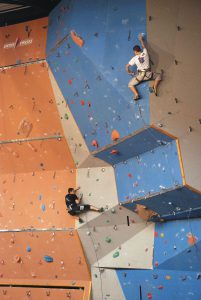
Lead climbing is rope climbing and bouldering combined. For indoor climbing, you will need the same items as sport climbing. In addition, you will also need your own climbing rope. You will be leading your rope up to the top of the climb by clipping into quickdraws hanging from bolts on your way up. In a climbing gym, there will be bolts and quickdraws setup for lead climbers. You will need to be a certified lead climber and lead belayer in order to lead climb. In our gym, we need to be able to climb 5.9 and higher comfortably before we can get certified to be a lead climber. Usually, there are lead climbing classes provided by the gym. Every gym requires that you are certified as a lead climber and belayer by the gym that you are visiting before you can lead climb in that gym.
It takes a lot of mental fearlessness for me to lead a climb. The lead climb is exhilarating and very scary at the same time. It is totally exhilarating when I make it to the top. For me, it is quite an accomplishment. The fall of the wall is the scariest thing. I had one unfavorable experience when I fell during a lead climbing class while working on a lead certification. I climbed close to the top and missed clipping into a quick draw. At the same time, my foot position was not adequate. It was close to the rope. When I fell, my foot snagged the rope and I landed upside down. Aside from being rope burned on my leg, my mental fearlessness dwindled.
Lead climbing is the hardest of all the three climbing venues that I have mentioned. There are many things to remember while climbing lead. The body position relating to the rope is very important. Make sure your feet position is always in the clear of the rope. When taking the lead class, you will learn how to belay and support a lead climber, how to tie the figure-eight knot, how to clip into the quickdraws, how to fall, and many more important tips on how to be a lead climber.
Practice falling is very important. You will get a chance to practice fall while you are taking a certified lead class. This will help prevent a mental block in fear of falling. It helps me but I have to keep reminding myself again and again.
The grading system for lead climbing is also the same as sport climbing. The advantage of lead climbing for me is mostly mental. Learning how to respect my fear of falling and how to deal with fear is humongous. I guess that is why it is so exhilarating to complete a lead climbing route. Also, learning to lead climb is a big step into rock climbing outdoor.
Overall rock climbing has rocked my world the last four to five years. I enjoy it tremendously. I hope this article also inspires you to try it out as well. If you are an expert rock climber, please send me lots of tips. I welcome your tips and feedback. Please leave me a comment in the box below.
Climb on my friends!

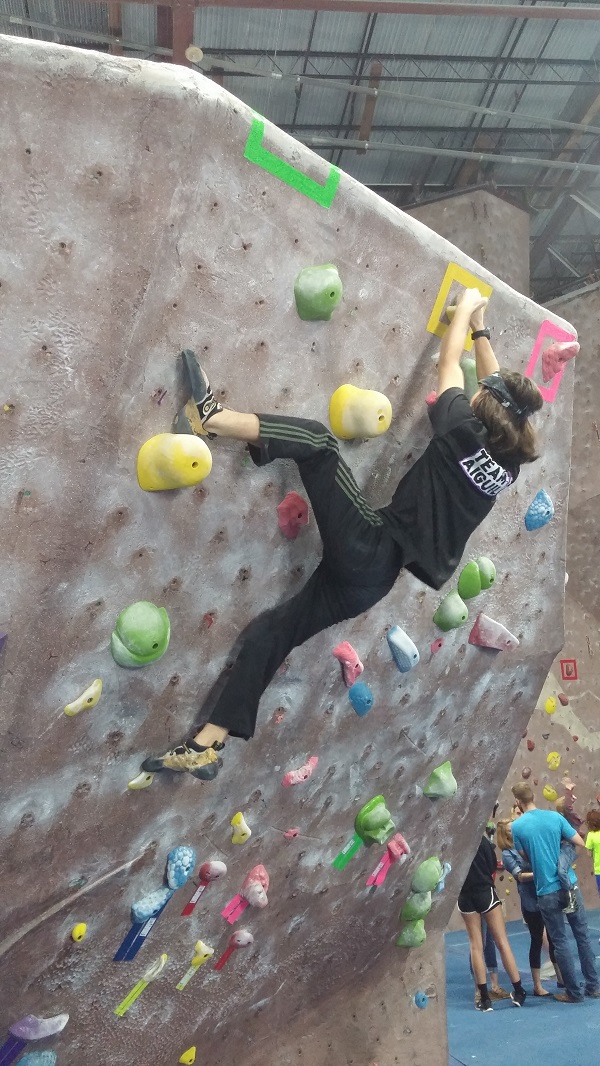

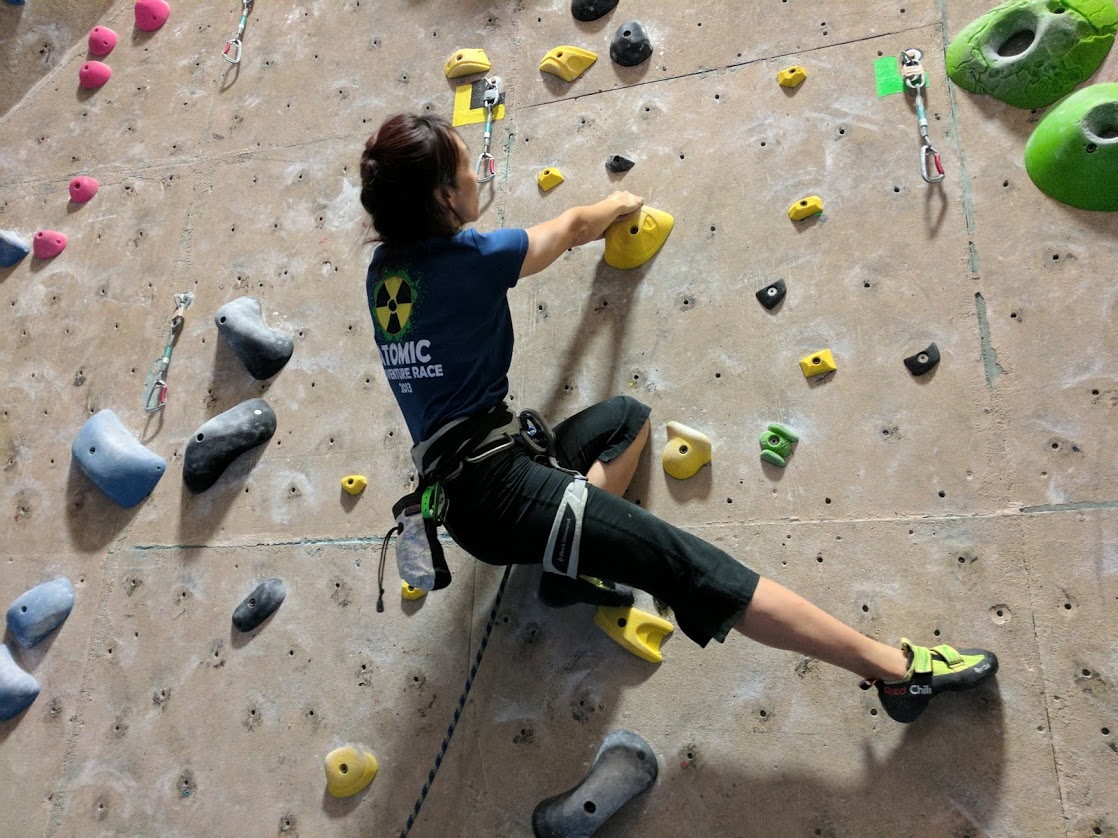
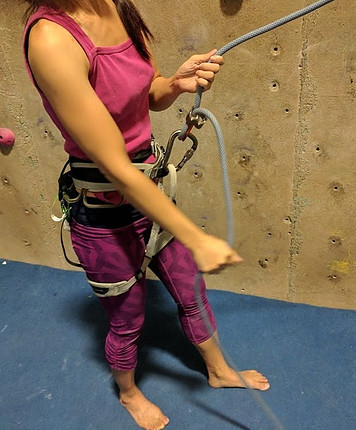
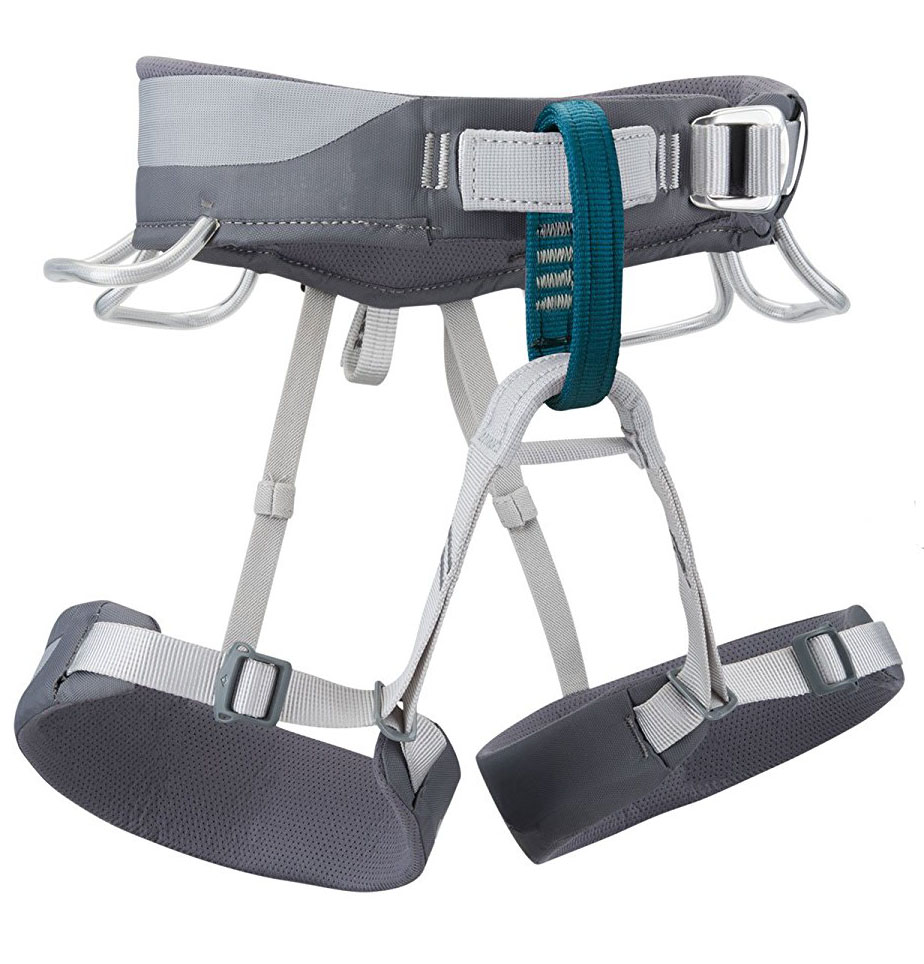
6 thoughts on “What is Rock Climbing?”
I have seen these rock climbing walls on the telly but never knew the ins and outs of what is available at comprehensive sites such as the Aiguille Climbing Centre.
I have had a fear of heights and climbing all my life which I would love to overcome. This controlled environment is ideal to gain confidence especially for the youngsters. It looks like really good fun, with safety precautions obviously a priority.
This is something I would definitely like to do. It is yet another way of strengthening the body and sharpening the mind. Now to see if they have a centre in our area of the UK and they will take oldies like myself!
Thank you for your thoughts. Rock climbing is a great way to overcome fear of height in a controlled environment. The climbing itself keep your mind entertained and distracted. It’s a great feeling of accomplishment when you get to the top.
I have seen as young as 3 years of age and as old as over 60s. One of our team coaches is in his mid 60s and he still climbs.
For me I have a fear of falling so when I climb I focused only looking up and one step at a time. I enjoy the balancing and the challenge of finding my way up. Strengthening the body and sharpening the mind is definitely the results of climbing.
I am sure you’ll find a gym near you in the UK as Rock climbing is becoming more and more popular every year and new gyms are being built everywhere.
If you have any additional questions, please visit my website any time and send me an email ha@rockClimbingForWomen.com. Thank you for your interests. Climb on my friend.
Hello, you wrote a fun and interesting article on indoor rock climbing. I didn’t have any idea it was as popular as it is.
It sounds like to me that you have as much fun as your son. How often do you go climbing and how long did it take you to learn how to climb?
Thanks for sharing this fun article.
Thank you Robert for your comment. Rock Climbing is a fast growing sport. It has been approved for the 2020 Olympics.
Yes, I do have as much fun as my son and I am also recruiting my husband as a partner to climb with. My son would rather climb with his friends.
I climb the same days as my son’s practice time: Tuesday, Thursday, and Saturday for around 2 hours each time. It did not take me too long to learn how to climb. At first I did the easy grade such as 5.6, 5.7, and 5.8. I slowly progressed to higher grades as I climbed more. It took me maybe six months to a year to become more efficient with more endurance. I can now climb most 5.10 and some 5.11. As of the current time, the hardest grade is 5.15.
Thank you again for spending the time to read my article. I am glad you enjoyed it. Climb on my friend.
Hey Ha:
What an intriguing post! I’ve always been fascinated by the pictures of the rock climbers hanging by one finger on some vast mountain face. It seemed like such a powerful statement.
It’s a lovely thing to understand (again) that all that strength, agility and confidence does have to start from somewhere.
Your explanations about the styles of climbing and your family’s own experiences with learning and growing in the sport are great. In their own way, they are very empowering.
Thank you for an awesome comment. You brought up a very good point regarding climbers who hanged by one finger off some vast mountain face. That in itself is inspiring and requiring some crazy gut. I, myself am a little timid in terms of hanging one finger let a lone off a cliff. It’s a little too extreme but you never know. If opportunity comes my way, I am wondering if I would do it? Hmmm… Maybe if someone pays me a billion dollar?
My approach are baby steps and at the same time I want to have fun. My way of having fun for rock climbing is to be able find an efficient way to balance myself to the next tricky move. The craziest thing I did was to be able to bring my right foot a little above my waist smearing against a small hold and press up with with my left hand against a hold below while my right hand reaching for a hold directly above my head. My left foot was propped against another small hold at the knee level. I am totally stretched out. The fun and challenging part is that I am able to reach the hold above my head and pull myself up.
By doing that particular move, almost all of my small muscles were engaged. When I pulled myself up not only my triceps and biceps were activated, my core and my quad were working in conjunction. That was the neatest ever.
My philosophy is that whatever you do whether it’s an extreme adrenaline pumping action above a cliff or a simple pull up motion five feet off the ground, do not forget to have fun…
Thank you for spending the time reading my article. If there are further questions or comments, please feel free to contact me through my website or via email ha@rockClimbingForWomen.com.